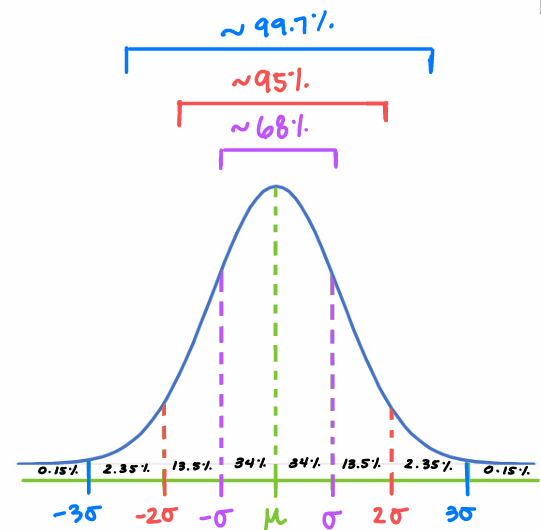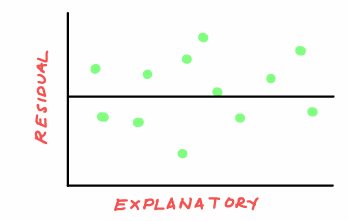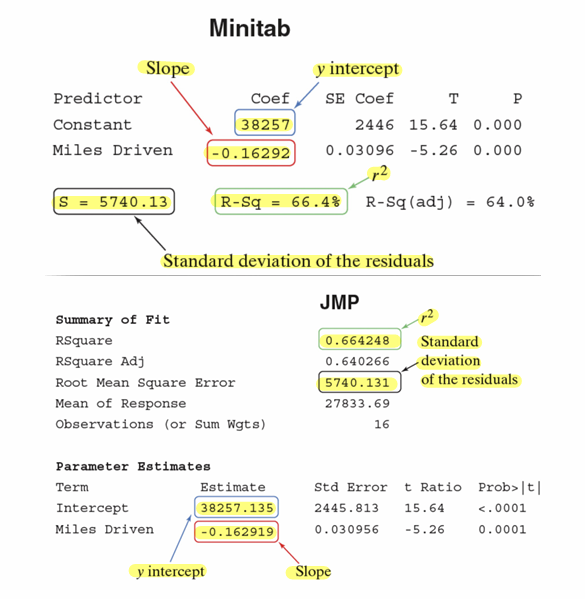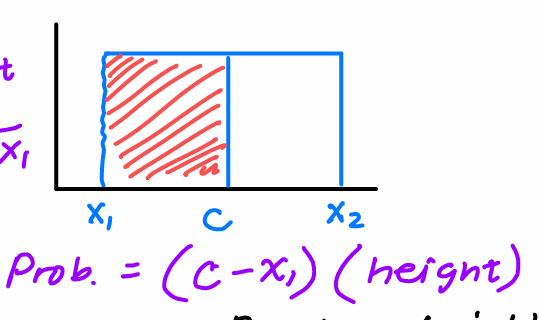AP Stat Last Minute Cram
1/124
Earn XP
Description and Tags
Name | Mastery | Learn | Test | Matching | Spaced |
|---|
No study sessions yet.
125 Terms
What to describe when asked “Describe the Distribution” or “Compare the distribution”
SOCV+ Context—(Shape, Outliers, Center, Variability)
Compare Center and Variability when asked to compare different distributions or data sets.
Describe Shape in Context
The distribution of (context) is (shape) with a peak at (highest point) and gaps between (gap)
Ex. The distribution of the exam scores is roughly symmetrical with a peak at 75 and gaps between 50 and 60.
Describe Outliers in Context
There seems to be outliers at (values)
Ex. There seem to be outliers at 95 and 20 in the exam scores distribution.
Describe Center in Context
The (mean/median) of the distribution is (mean/median + units).
if symmetric—use mean
if skewed—use median
Ex.The mean of the distribution is 75 points. (If skewed, use median instead.)
If asked to compare: Compare which is greater to that which is lesser
Describe Variability in Context
The distribution of (context) has a (SD/IQR/Range + units).
Ex.The distribution of the exam scores has a standard deviation of 10 points.
If asked to compare: Compare which distribution varies more
Interpret SD
“The (context) typically varies by about (SD + unit) from the mean of (mean+unit)”
Parameter
A number(or statement) that describes a population
Statistic
A number(or statement) that describes a sample
5 Number Summary
Minimum
Q1(25th Percentile)
Median
Q3(75th Percentile)
Maximum
2 Ways to Describe Location
Percentiles or Standardized Scores(z-scores)
Interpret a Z-Score
“(context) is (z-score) standard deviations (above(+)/below(-)) the mean of (μ+units)
Addition/Subtraction of Data
Shape- No change
Center/Location-±a
Variability- No Change
Multiplication/Division of Data
Shape- No change
Center/Location-x/÷ b
Variability-x/÷ b
Density Curves
models the distribution variable with a curve that:
is always above the horizontal axis
has exactly an area of 1 under it
Mean of a Density curve- Point at which the curve would balance if made of a solid material
Median of a Density curve- is the point that divides the area under the curve in half
Approximately Normal/Normal Curve
Roughly symmetric, single-peaked, bell-shaped density curve
Normal Dist. specified by 2 parameters: mean & SD
Empirical Rule
68-95-99.7 Rule

How to describe a scatterplot
Direction:(Positive/Negative/None)
Unusual Feature:(Outlier)
Form:(Linear/Nonlinear)
S:(Weak/Moderate/Strong)
*Describe Direction+Strength using correlation( r ), if given
Interpret a Scatterplot
“There is a (strength), (correlation), (form) relationship between (explanatory variable) and (response variable). There does/doesn’t seem to be unusual features in this relationship.(If yes, describe)”
Ex. There is a strong, positive, linear relationship between studying time and test scores. There doesn’t seem to be unusual features in this relationship.
Interpret Correlation( r )
“The correlation of r= ( r ) confirms that the linear association between (explanatory variable) and (response variable) is (positive/negative) and (weak/moderate/strong).”
Interpret Residuals—(Actual-Predicted)(y-ŷ)
“The actual (y-context) was (residual value) (above/below) the predicted value for x=(# in context)”
Interpret Slope(b)
“For every increase in (x-context) the predicted (y-context) (increases/decreases) by (slope unit of y).”
Interpret y-int(a)
“When (x-context) is 0, the predicted (y-context) is (y-int).”
Interpret Standard Deviation(In terms of LSRL)
“The actual (y-context) is typically about (s+unit) away from the number predicted by the LSRL with x=(context)
Context of Coefficient of Determination(r²)
“About (r²)% of the variability in (y-context) is accounted for by the LSRL at (x-context)
LSRL(Least Squares Regression Line) Equation
ŷ=a+bx
ŷ=predicted y
a=y-int
b=slope
x=explanatory variable
To find LSRL Eq. on Calc- Stat>Calc>8:Lin Reg(a+bx)
Residual Plot
Identifies if a Linear Model is appropriate
Appropriate if no leftover curved pattern

To find a & b
b=r * Sy/Sx a=ȳ-bx̄
Extrapolation
Explanatory Variables that are outside of the range of data which the LSRL was calculated
Influential Points
Can greatly affect correlation and regression calculaltions
Outliers
Out of pattern(large residuals)
High Leverage
Very large x-values
To tell if the Power Model is the best fit
Option 1: Raise the values of the explanatory variable by an integer, p
Option 2: Take the pth root of the response variable
To tell if the Exponential or Logarithmic Models are the best fit
Take the logarithm(log or ln) of one or both variables
Computer Generated Values

How to choose an SRS
Label, Randomize, Select
Must Be Without Replacement
Stratified Random Samplling
Taking a random sample from each strata(group)
More Precise Estimate
Cluster Sampling
Randomly select entire clusters- all individuals in the selected clusters are part of the sample
Saves time and money
Systematic Random Sample
Choose a k value, randomly select a starting value from 1 to k, choose every kth individual from the starting individual
Convenience Sampling
Choose individuals that are easiest to reach-BIAS
Voluntary Sampling
Individuals choose to be a part of the study b/c of open invitation-BIAS
Undercoverage
When some members of the population are less likely to be chosen or cannot be chosen in a sample
Nonresponse
When an individual chose for the sample can’t be contacted
Response Bias
When there is a systematic pattern of inaccurate answers to a survey question
Completely Randomized Design-Experiments

Randomized Block Design

Observational Study
Observes individuals and measures variables of interest but observes without influencing the response
Experimental Study
Deliberately imposes treatments on individuals to measure their responses
Matched Pairs Design
Uses blocks of size 2; twins especially
Statistically Significant
The observed results of a study are too unusual to be explained by chance alone
Probability for Statistical Significance
%<= 5% means something is statistically significant
Process of Identifying the Percentage(p-value)
Identify the difference in mean
Make a simulation and dotplot
Identify how many dots are greater of equal to the difference in mean from step 1
Calculate the percentage of how many dots are greater than or equal to the mean difference
Compare to the 5% rule and state if the study is statistically significant or not in the context of the problem
Scope of Inference
Random Selection of individuals allow inference about the population from which the individuals were chosen
Random Assignment of individuals to groups allows inference about cause and effect
P(A)
number of outcomes in event A/total number of outcomes in sample space
Complement Rule
P(Ac)=1-P(A)
Addition Rule for Mutually Exclusive Events
P(A U B)= P(A) + P(B)
General Addition Rule
P(A U B)= P(A) + P(B) - P(A ∩ B)
Conditional Probabilities(“given that”)
P(A|B) = P(A ∩ B) / P(B) = P(both events occur)/P(given event occurs)
Independent Events
P(A) = P(A|Bc)=P(A|B)
General Multiplication Rule
P(A ∩ B) = P(A) * P(B|A)
Multiplication Rule for Independent Events
P(A ∩ B) = P(A) * P(B)
“At least one” Probability Rule
P(at least one)=1-P(none)
Law of Large Numbers
If we observe more and more trials of any random process, the proportion approaches the true probability
Mutually Exclusive
No event can happen at the same time
Simulation
Imitates a random process in such a way that simulated outcomes are consistent with real-world outcomes
Simulation process:
1) Describe how you will simulate one trial(one repetition)
2) Perform many trials(repetitions)
3) Use the result to answer the question
Conditional Probability
Probability that one event happens given that another event is known to have happened
Independent Events
If knowing whether or not one event has occurred does not change the probability that the other event will happen
Mean/Expected Value
μX=E(X)=ΣxiP(xi)
Discrete Random Variable
Uses summation to calculate probabilities and means
Continuous Random Variable
Probabilities are areas under a density curve
Height of Density Curve
1/X2-X1
Probability of C

Combining Random Variables

Independent Random Variables
When x cannot hep or predict the value of y
Knowing the value of one variable does not change the probability of the other variable
Variance
σ2
Binomial Random Variables
When you have a fixed number of independent trials with the same probability of success
Conditions for Binomial Setting
BINS
Binary-”success” or “fail”
Independent-Knowing the outcome of one trial does not or tell us anything about the outcome of other trials. Or 10% Cond.
Number- fixed n number of trials
Same Probability- same probability p for every trial
10% Condition
If a binomial setting is not independent, we can use the 10% condition to treat each individual as independent
sample<=.1(population)
n<=10%N
Large Counts Condition
Helps us identify that the probability distribution of X is approximately Normal
n(p)>=10
n(1-p)>=10
Binomial Probability
P(X=x)=(nCx) (p)x(1-p)n-x
Mean(Expected Value)-Binomial
E(x)=np
SD-Binomial
\sqrt{np\left(1-p\right)} =σx
Geometric Random Variable
When you're counting the number of trials until the first success
Probability-Geometric
P(X=x)=(1−p)x−1p
Mean-Geometric
μ=p/1
SD-Geometric
\frac{\sqrt{1-p}}{p} = σ
Shape of Geometric Distribution
Always right-skewed when small sample size
-shape is right-skewed, p<.5
-shape is left-skewed, p>.5
-shape is approximately normal, p=.5
Interpretation of Probability
“There is a (probability/percentage) chance/probability of (context)”
Interpretation of Mean
“If many, many (unit) were randomly selected, the average (context) is about (μ + unit)”
Interpretation of SD
“If many, many, (unit) were randomly selected, the (context) typically varies by about (σ + unit) from the mean of (μ + unit)”
Describing Random Variable(Discrete, Continuous, Binomial, or Geometric)
Describe the Shape, Center, & Variability
Population Distribution
Values of ALL individuals in a sample
Sampling Distribution
Values of ALL POSSIBLE samples of the same size from the same population
Unbiased Estimator
If the center(μp̂ or μx̄) in equal to the true value of the parameter(p or μ)
Central Limit Theorem
If the population distribution is not Normal, but the sample size is large enough(n>=30), the sampling distribution is approx. Normal by CLT
Point Estimate
A chosen statistic(p-hat, x-bar, Sx) that will provide a reasonable estimate about the parameter
A+B/2
Margin of Error Strength
Confidence Level +; ME +(wider intervals)
Sample Size +; ME -(narrower intervals)
How to make a Confidence Interval(One Sample)
Choose: One-Sample z interval for p
Conditions: Random, 10%, Large Counts
Calculate: Stat>Tests>1-PropZInt
x:n(p-hat)
n:sample size
c-level:c%
Conclude: Interpret
How to make a Confidence Interval(Two Sample)
Choose: Two-Sample z interval for p1-p2
Conditions: Random, 10%, Large Counts (For Both Samples)
Calculate: Stat>Tests>2-PropZInt
x:n(p-hat)
n:sample size
c-level:c%
Conclude: Interpret
Convincing Evidence in Confidence Intervals
(+,+)-1st proportion is greater
(-,-)-2nd proportion is greater
(+,-)- No convincing evidence of a difference b/c interval contains 0
Interpretation of a Confidence Interval
We are (c%) confident that the interval from A to B captures the p=true proportion of [parameter in context].